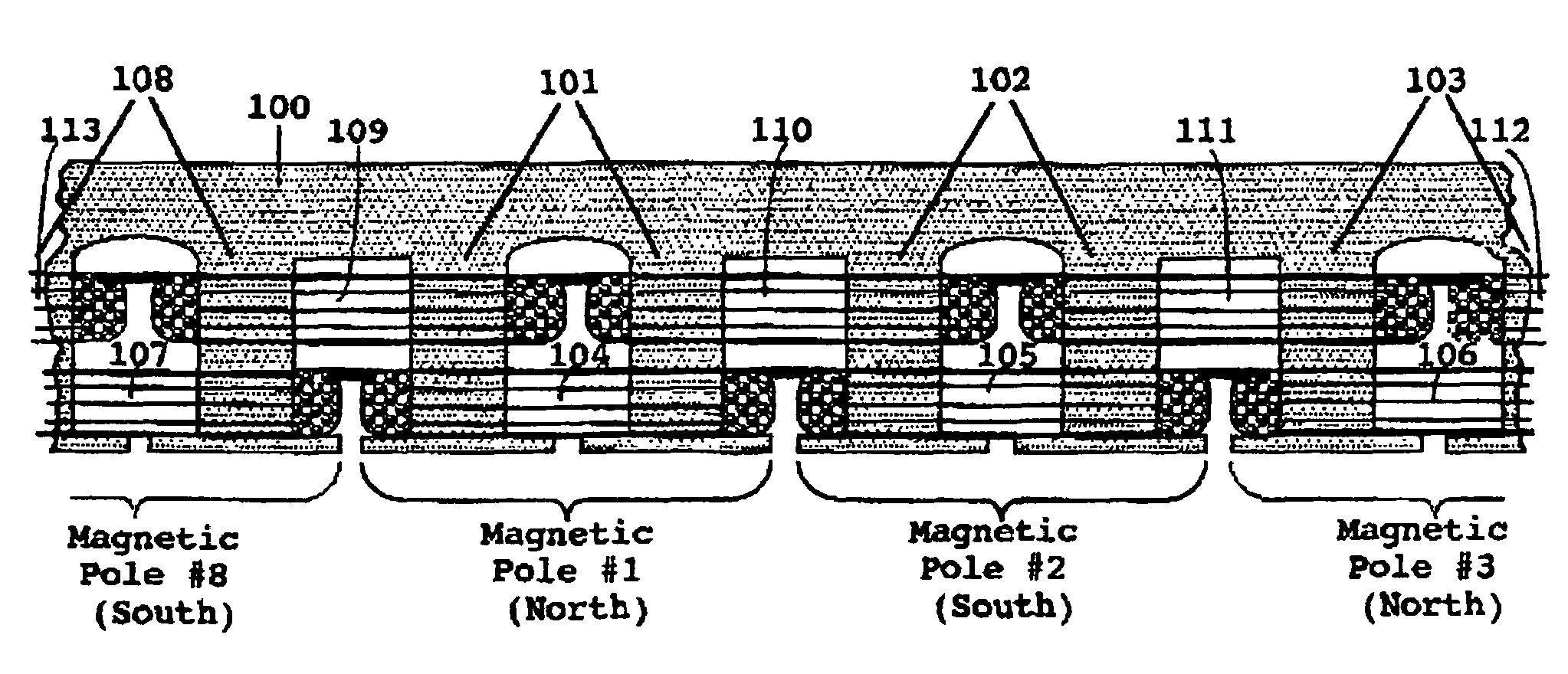[0009]In this disclosure, the effect of the invention will be called the Field-Match effect. The reason for the use of the word “match” is that it has two near opposite meanings: one which means “to agree, to be alike” (which we will designate “match1”) and another meaning which means “to oppose”, as in a “football match” (which we will designate “match2”). The torque produced by the
stator on the rotor of the Split-Pole Field-Match Motor is caused by a unique design in which two coil fields of near equal value are matched on a single
stator pole, alternately, in both senses of the word “match”.
[0010]First, they are “matched1” in one part of the electrical phase as like-fields on the same pole which series and causes the pole to exert a magnetomechanical force on a laminated, ferrite, salient poled rotor, then the coils are “matched2” as opposing fields on the same pole in the opposite part of the electrical phase and the opposing magnetomotive forces exerted on the pole cause there to be no magnetomechanical force exerted on the ferrite rotor, as no flux is manifested from the pole.
[0011]The Split-Pole Field-Match Motor uses this concept to integrate all the active
magnetic components of a motor into the stator which interacts with a laminated salient pole rotor in a smooth and efficient way which makes it unnecessary to use an induction rotor. This makes the stator-rotor configuration look much like that of a variable
reluctance motor However, the split-pole field-match
system used in the stator of this motor to cause torque on the rotor creates the torque in a very different manner from that of any variable
reluctance motor now in use, and this distinction will be easily appreciated from the following description. The Split-Pole Field-Match motor integrates direct current (DC) coils and
alternating current (AC) coils on the stator in an overlap configuration to create field concentrations on alternate sets of half-poles on the stator.
[0012]With the method of the invention, the split-pole field-match
system can produce motors whose operation requires only a single-phase
system and produces competitive results equal to motors which require the controller to provide multi-phase operation, thus making the use of less expensive controllers for the same result possible.
[0013]It is anticipated that one of the major embodiments of this
motor system will provide a new alternative for applications which now use brushless DC motors with the
advantage being cost and a wider RPM range due to the
inherent safety and durability of the salient pole ferrite rotor which requires no induction coils or casings or no magnets which require lower top RPM to remain within a safe range.
[0014]In the disclosed embodiment of the invention, an even number of poles are defined upon the
electric motor stator, and two adjacent poles are defined as a set A second set of a pair of poles constitute one of the poles of the first set and the adjacent pole not of the first set. Accordingly, first and second sets of poles will be adjacent and include a common pole. The first set of poles is wound with a direct current coil, and a second set of poles is wound with an alternating current coil. This arrangement causes the first pole set to have a complete DC coil wound thereabout and two one-half alternating current coils disposed thereon. The second set of poles will include a full AC coil and two one-half DC coils. The DC coils are energized through a
rectifier to rectify the AC quasi-
sine wave from an
inverter circuit, or the AC from traditional wall current, connected to the AC coils. The AC coils are all connected into series with each other, and likewise, the DC coils are all connected into series with each other. Thereby, the
AC current within the AC coils will be perfectly in synchronization with the rectified DC pulses in the DC coils, and the result is that one of the poles of the first pole set alternately is polarized with a predetermined polarity which is intensified by the effects of the two coils influencing the pole, and the other pole of the set will be neutralized due to the opposite polarity effect of the coils while the first pole is being polarized. In the second set of poles, the non-common pole will be alternately polarized oppositely with effect to the polarized first pole set and alternately neutralized This inter-connection and energization of poles results in alternate poles being oppositely polarized while having a neutralized pole in between This polarity arrangement will cause rotation of the rotor due to the attraction of the rotor poles to opposite polarity
stator poles.
 Login to View More
Login to View More  Login to View More
Login to View More 


